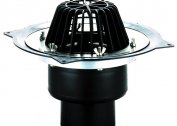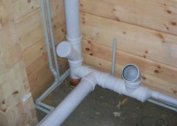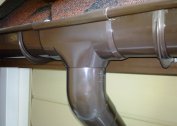Autonomous sewage is an important detail in creating a cozy country house. Many owners of cottages are interested in the question of how to make it with their own hands, without involving outside specialists for a lot of money. This process can be completed independently, having the necessary skills and tools. The following recommendations will help you in creating comfort in a country house.
What type of autonomous sewage to choose
 If your country house or land is far from communication systems, then you can’t do without autonomous sewage. Earlier cesspools were used everywhere, but they are replaced by modern and convenient systems - septic tanks, dry closets and autonomous stations.
If your country house or land is far from communication systems, then you can’t do without autonomous sewage. Earlier cesspools were used everywhere, but they are replaced by modern and convenient systems - septic tanks, dry closets and autonomous stations.
Choosing the type of local sewage system for your site, you should consider a number of factors:
- soil composition;
- depth of wastewater;
- the number of people who will use the sewer;
- composition and quantity of plumbing equipment;
- the possibility of access of a cesspool truck;
- duration of stay in the house.
Cesspools
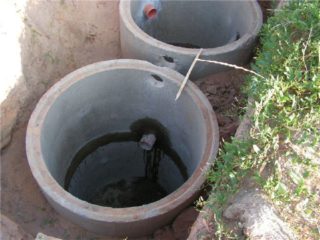 This is the simplest and most well-known option for local sewage. Before, filter pits were created everywhere, which allowed liquids to enter the soil and retain solid waste. But today, such designs are mostly prohibited, as these are time bombs in your area. Uncleaned sewage flows into the ground, therefore there is a high probability of the penetration of hazardous contaminants into aquifers and drinking water, which will make it hazardous for use.
This is the simplest and most well-known option for local sewage. Before, filter pits were created everywhere, which allowed liquids to enter the soil and retain solid waste. But today, such designs are mostly prohibited, as these are time bombs in your area. Uncleaned sewage flows into the ground, therefore there is a high probability of the penetration of hazardous contaminants into aquifers and drinking water, which will make it hazardous for use.
An alternative and safer option is a drain pit, which is a sealed tank. Such an installation minimizes the likelihood of soil contamination, and also almost does not create an unpleasant odor. The disadvantage of this option is that you will often have to pump out waste from the tank, hiring sewage trucks.
A drain pit consists of a pipeline that discharges waste water from the house, and a storage tank. Capacity can be made of:
- concrete;
- brick;
- metal with anti-corrosion coating;
- plastic.
Plastic options are considered optimal for do-it-yourself sewer equipment. The tank is installed underground at a distance of at least 5 meters from the house. It is also necessary to leave a place for the entrance of the cesspool machine.
Such a tank is created as follows:
- Digging pit. The height should take into account the depth of freezing of the soil.
- At the bottom of the pit, a base of 20-25 cm of sand and small gravel is mounted.
- At the bottom, a container of any material is installed, it is connected to the sewer pipe. Joints need to be sealed.
- The outlet is closed by a hatch. Reconciling a layer of sand and soil.
Septic tank
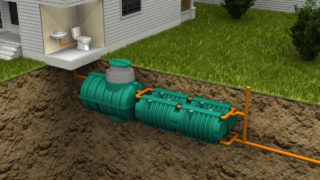 The optimal solution for an autonomous drainage system today is considered a septic tank. Such a system is reliable in use and does not require complex and expensive maintenance.
The optimal solution for an autonomous drainage system today is considered a septic tank. Such a system is reliable in use and does not require complex and expensive maintenance.
There are several models of septic tanks suitable for private houses:
- Septic tank small single chamber. This option is suitable for a house in which no more than 2 people permanently live, not spending a lot of water.
- The septic tank is small for 2 or 3 cameras. Suitable for larger houses. In the large capacity of such a septic tank, sludge is formed as a result of the natural processing of solids. Sludge needs to be pumped out 2 times a year. Substances to be removed also settle in a small container.
- Septic tank multi-chamber. These septic tanks are expensive, so they are most often mounted for a group of houses that are not far from each other.
Septic can be created from different materials:
- Reinforced concrete.This design is suitable for single chamber version. It does not leak water, is resistant to corrosion.
- Monolithic concrete. Suitable for a two-chamber septic tank. Reliable and relatively cheap option.
- Brick. Such a septic tank will differ from ordinary brickwork only with a waterproofing layer.
- Plastic. A huge advantage of this design is that you buy a module that is immediately ready for installation. It is considered the best option, although it costs more than brick and concrete options.
The process of constructing a local septic tank is not particularly difficult:
- Digging pit. A 150 mm layer of sand, a foundation or a concrete slab is laid at its bottom.
- The septic tank itself is installed. The structure must be carefully lowered to the bottom of the pit and filled with water. After that, sand is poured into the voids on the sides.
- Tertiary treatment. If tertiary treatment is provided for in the filtration fields, they should be located at a distance of more than 50 meters from the water source, 30 meters from the reservoir and 5 meters from the dwelling.
- Pipe laying. At a depth of 50 cm, dig trenches, cover the bottom with sand and lay pipes. A layer of sand and soil are poured on top.
Dry closet
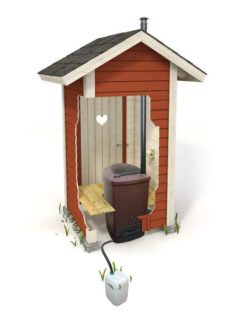 The simplest design of the dry closet consists of 2 containers that are interconnected. Upper - the reception department, lower - for the collection and disposal of waste. Dry closets are:
The simplest design of the dry closet consists of 2 containers that are interconnected. Upper - the reception department, lower - for the collection and disposal of waste. Dry closets are:
- electric;
- liquid;
- peat.
The best option for a private house are peat dry closets. Electrical options require large financial costs, while liquid ones require a lot of water and biological products.
The simplest option is a peat dry closet, consisting of:
- toilet seat or seat (instead of the toilet);
- containers for peat;
- pits for composting waste.
The principle of operation of such a toilet is as follows. Waste is collected in containers with peat, and a new portion of the mixture is poured on top of them. Often sawdust is added to this mass in a ratio of 1: 1. In this case, the filling of the tank will occur in layers.
Stages of work to create a peat dry closet:
- Decide on its location (in a specially equipped room at home or in a separate street building).
- Installing a tank or bucket of peat where waste will be collected.
- A toilet seat is attached above the container. If the waste container has a large volume, then on the side you need to make a hatch to clean it.
- Next to this design is a tank with peat. The substance is regularly added on top of the waste.
- In the yard it is necessary to equip a compost pit into which waste from the dry closet will be poured.
- Discharge of liquids is carried out through a branch pipe. It is displayed in a pre-prepared trench.
Autonomous stations
 Thanks to such constructions, the waste goes through two stages of treatment: mechanical (as in a septic tank, only without soil post-treatment) and biological, where it is treated up to 98-100%.
Thanks to such constructions, the waste goes through two stages of treatment: mechanical (as in a septic tank, only without soil post-treatment) and biological, where it is treated up to 98-100%.
Modern bioremediation stations artificially oxygenate wastewater. Water purified in this way can be safely drained or used to water the garden. Installation is as follows:
- We determine the place under the station, dig a hole there, the dimensions of which depend on the dimensions of the station.
- We dig a trench 50-60 cm deep with a slope of 3% for a 110 mm sewer pipe.
- We tear out another trench under the outlet pipe with the same diameter, but additionally insulated.
- We lower the station into the foundation pit, level it and connect the pipes (inlet and outlet).
- We bring an electric cable to the station and connect it according to the instructions.
- We connect an emergency lamp and a float.
- We pre-launch the station, check the operation of all airlift pumps, heating cable and other systems.
- We make a full filling of the station and trenches.
Prevention to avoid problems
Whatever option of autonomous sewage you choose, it is very important to carry out treatment activities in time.First of all, this applies to cesspools, but other systems require careful maintenance.
Cleaning the autonomous sewage system must be carried out in accordance with the operating rules inside the house piping networks and external treatment facilities (sumps).
If the solid waste that accumulates at the bottom of the sump in the form of sludge is not removed in a timely manner, it is gradually compressed and converted into a clay-like material. In this case, the cleaning process will require an order of magnitude more effort and financial investment.
In addition to the removal of effluents from treatment facilities, flushing of the pipeline network should also be carried out. Such prevention significantly reduces the likelihood of blockages and extends the life of the sewer system of a private house.
On average, treatment activities are carried out with the following frequency:
- cesspool and single chamber septic tank - once a quarter;
- multi-section septic tank - once every six months;
- cleaning station and dry closet - once a year.
